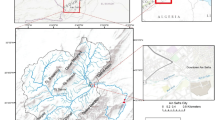Abstract
A digital relief model of a mountain cluster and location schemes of mountain collectors and reservoir dams were used to develop a numerical hydrodynamic 2D-model of the mountain part of the drainage basin of Gelendzhik City area and to perform variant calculations of rain flood waves, taking into account their transformations in mountain collectors and accumulation in reservoirs. The rains considered in the model were assumed to have the exceedance probability of 1% and the duration of 20 and 720 min (12 h) with a total rainfall depths of 51 and 206 mm, respectively. Conclusions were made that the carrying capacity of the collector should be calculated for the parameters of a short-time intense rain and that the accumulating hydraulic structures, for their efficient operation, should be designed to allow continuous regulation of discharge rates.








Similar content being viewed by others
REFERENCES
Aleksyuk A.I., Belikov V.V., Programmnyi kompleks STREAM 2D CUDA dlya rascheta techenii, deformatsii dna i perenosa zagryaznenii v otkrytykh potokakh s ispol’zovaniem tekhnologii Compute Unified Device Architecture (na graficheskikh protsessorakh NVIDIA). Svidetel’stvo o gos. reg. programm dlya EVM № 2017660266 ot 20.09.2017 (Software System STREAM 2D CUDA for Calculating Currents, Bed Deformations, and Pollution Transport in Open Flows with the use of Compute Unified Device Architecture technologies (on NVIDIA Graphical Processors). Certificate of State Registration of Software Programs no. 2017660266 of September 20, 2017).
Belikov, V.V. and Aleksyuk, A.I., Modeli melkoi vody v zadachakh rechnoi gidrodinamiki (Shallow-Water Models in River Hydrodynamic Problems), Moscow: RAN, 2020.
Kurganov, A.M., Tablitsy parametrov predel’noi intensivnosti dozhdya dlya opredeleniya raskhodov v sistemakh vodootvedeniya. Spravochnoe posobie (Tables of Parameters of Limiting Rain Intensity for Determining Discharges in Water Disposal Systems. Reference Book), Moscow: Stroiizdat, 1984.
Opredelenie raschetnykh kharakteristik maksimal’nogo za god sloya osadkov razlichnoi prodolzhitel’nosti dlya g. Gelendzhik i g. Sevastopol’ po dannym nablyudenii i modelirovaniya (Determination of Design Characteristics of the Maximal Annual Precipitation Depth for Different Rain Durations for Gelendzhik and Sevastopol cities based on Observation and Simulation Results), Moscow: Gidromettsentr Rossii, 2022. Versiya 30.03.2022.
SP 32.13330.2018 Kanalizatsiya. Naruzhnye seti i sooruzheniya. Aktualizirovannaya redaktsiya SNiP 2.04.03-85 (s Izmeneniyami № 1, 2) (Sewerage. Exterior Grids and Structures. Actualized Version of SNiP 2.04.03-85 (with Amendments no. 1 and 2).
Sribnyi, M.F., Normy soprotivleniya dvizheniyu estestvennykh vodotokov i raschet otverstii bol’shikh mostov po sposobu bytovykh morfologicheskikh kharakteristik (Standards of the Resistance to Flow in Natural Watercourses and the Calculation of the Openings in Large Bridges by the Method of Common Morphological Characeristics), Moscow; Leningrad: Gostransizdat, 1932.
Shterenlikht, D.V., Gidravlika (Hydraulics), Moscow: KolosS, 2004.
Aleksyuk, A.I. and Belikov, V.V., Simulation of shallow water flows with shoaling areas and bottom discontinuities, Comput. Math. Math. Phys., 2017, vol. 57, no. 2, pp. 318–339.
Aleksyuk, A.I. and Belikov, V.V., The uniqueness of the exact solution of the Riemann problem for the shallow water equations with discontinuous bottom, J. Comput. Phys., 2019, vol. 390, pp. 232–248.
Aleksyuk, A.I., Malakhov, M.A., and Belikov, V.V., The exact Riemann solver for the shallow water equations with a discontinuous bottom, J. Comput. Phys., 2022, vol. 450, no. 110801.
Vasilieva, E. and Belikov, V., Numerical modeling of a hydrodynamic accident at an earth-and-rockfill dam on the Dyurso River, Power Technol. Eng., 2020, vol. 54, pp. 326–331.
Vasil’eva, E.S., Belyakova, P.A., Aleksyuk, A.I., Selezneva, N.V., and Belikov, V.V., Simulating flash floods in small rivers of the Northern Caucasus with the use of data of automated hydrometeorological network, Water Resour., 2021, vol. 48, pp. 182–193.
Funding
The study was carried out under Governmental Order to WPI Ras, subject FMWZ-2022-0003 “The Development of Numerical Models of Hydrological, Hydrodynamic, and Hydrochemical Processes in Water Objects and Their Drainage Basins; the Use of the Models to Develop Decision-Support Procedures in the Sphere of Water Safety for Information Modernization of the Water Management Sector of Russia.”
Author information
Authors and Affiliations
Corresponding author
Rights and permissions
About this article
Cite this article
Belikov, V.V., Borisova, N.M. Numerical 2D-Modeling of Rain Runoff Transformation in the Drainage Basin of Gelendzhik City Taking into Account the Mountain Collector and Accumulating Reservoirs. Water Resour 50, 482–490 (2023). https://doi.org/10.1134/S0097807823040048
Received:
Revised:
Accepted:
Published:
Issue Date:
DOI: https://doi.org/10.1134/S0097807823040048




